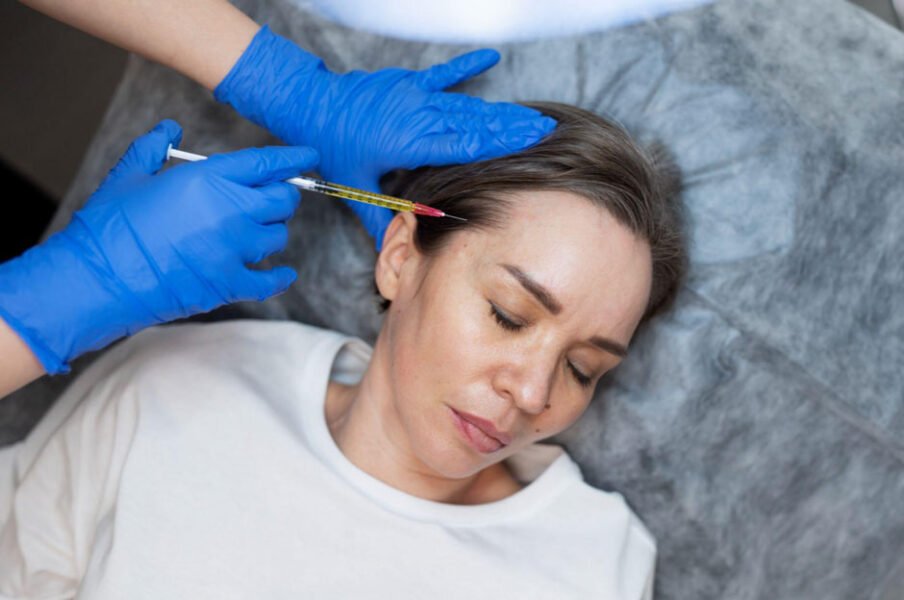Skip to the good bit
ToggleIntroduction: When Science Fiction Meets Modern Medicine
Not long ago, the idea of using your own blood to regenerate hair growth would have sounded like something straight out of a science-fiction script. Yet today, that very concept—Platelet-Rich Plasma (PRP) therapy—has emerged as one of the most promising, evidence-based treatments for hair restoration.
Once limited to the realm of elite athletes and medical research, PRP therapy has now become a mainstream solution for hair restoration. This innovative procedure is transforming the way we address hair loss, combining regenerative medicine with precision aesthetics to deliver results that look and feel entirely natural.
But what exactly is PRP therapy, and why is it earning a reputation as a game-changer in scalp health? Let’s explore the science, process, and proven results that have brought this once-futuristic idea firmly into reality.
Understanding PRP Therapy: Science at the Cellular Level
PRP therapy begins with a small sample of the patient’s blood, which is then processed in a centrifuge to separate its key components. This step concentrates the platelet-rich plasma, a golden fluid abundant in growth factors and bioactive proteins.
When this concentrated plasma is re-introduced into the scalp through micro-injections, it stimulates dormant hair follicles, enhances blood circulation, and promotes the regeneration of healthier, thicker strands. Essentially, PRP leverages the body’s own repair mechanisms to encourage hair growth, without the use of synthetic drugs or invasive surgery.
To put it simply, PRP therapy transforms your blood into a personalized healing serum. It’s regenerative medicine in its purest form, using your body’s biology to repair and restore itself.
The Science Behind Hair Regeneration
The effectiveness of PRP lies in its molecular composition. Platelets release powerful growth factors such as PDGF (Platelet-Derived Growth Factor), VEGF (Vascular Endothelial Growth Factor), and EGF (Epidermal Growth Factor), each playing a vital role in tissue repair and follicle stimulation.
PRP therapy has demonstrated significant improvements in hair density, thickness, and scalp vascularization when performed in multiple sessions. These findings reinforce PRP’s place as a safe and clinically validated alternative to conventional hair loss treatments.
Because PRP is derived from the patient’s own blood, it also eliminates the risk of allergic reactions or adverse immune responses. This makes it a remarkably biocompatible and sustainable solution for long-term hair restoration.
From Sports Medicine to Aesthetic Innovation
Originally developed for orthopedic and sports medicine applications, PRP gained attention after elite athletes used it to accelerate tissue recovery. As researchers studied its regenerative potential, aesthetic medicine quickly recognized its transformative possibilities.
Today, PRP therapy is an integral part of modern dermatology and trichology. The procedure has been refined over time, with advanced centrifugation techniques and precise injection methods now used to optimise growth factor concentration and overall results.
What Happens During a PRP Session
A PRP hair restoration session typically follows these key steps:
- Blood Collection: Around 10–20 ml of blood is drawn from the patient’s arm.
- Centrifugation: The blood sample is spun at high speed to separate platelet-rich plasma from red and white cells.
- Activation: In some cases, calcium chloride or other activating agents are used to enhance the release of growth factors.
- Injection: The prepared PRP is injected into targeted areas of the scalp using fine needles, focusing on zones affected by thinning or hair loss.
The entire session usually lasts under an hour, and patients can resume normal activities almost immediately afterward. Mild redness or tenderness may occur temporarily, but downtime is minimal.
Clinical Outcomes: What the Research Shows
The most compelling evidence for PRP’s success comes from both scientific research and real-world outcomes. Clinical data demonstrate that PRP can increase hair count, improve shaft thickness, and enhance overall scalp health.
Regular PRP sessions, typically spaced about a month apart, produced noticeably thicker and stronger hair after three to four treatments. Participants also reported less shedding and an overall improvement in hair texture.
Importantly, PRP results develop gradually. Because the process triggers natural growth cycles, full improvements typically become noticeable after several months, with continued progress over time.
Who Can Benefit from PRP Therapy?
PRP therapy is suitable for both men and women experiencing early-stage hair thinning, androgenic alopecia (pattern baldness), or diffuse shedding due to stress, hormonal changes, or postpartum recovery.
It’s particularly beneficial for individuals who want a natural, drug-free solution that stimulates growth without altering hormones or requiring surgical intervention.
Many professionals view PRP as part of a holistic approach to self-care, combining aesthetics, wellness, and confidence in one procedure.
“Plasma for Hair Loss”: The Regenerative Revolution
The concept of plasma for hair loss encapsulates a fundamental shift in medical aesthetics, from artificial enhancement to biological regeneration. By utilizing the patient’s own plasma, PRP activates cellular renewal processes that naturally restore scalp vitality.
It’s a personalized treatment that reflects the growing preference for regenerative therapies, solutions that work with the body, not against it. PRP’s success is a glimpse into the future of medicine: targeted, individualized, and profoundly effective.
Why PRP Continues to Gain Global Recognition
The rising popularity of PRP therapy can be attributed to three critical factors:
- Proven Efficacy: Studies confirm measurable improvements in hair growth, thickness, and scalp circulation.
- Safety Profile: As an autologous treatment, PRP carries virtually no risk of allergic or immune reactions.
- Minimal Downtime: Unlike surgical procedures, PRP requires no recovery period, making it ideal for modern lifestyles.
This combination of science, safety, and simplicity has positioned PRP as one of the most forward-thinking treatments in the field of aesthetic medicine.
Training and Expertise: The Human Factor Behind the Technology
While the science of PRP is impressive, the success of the procedure depends heavily on practitioner skill. Proper centrifugation speeds, platelet concentration ratios, and injection depth all determine the final outcome.
Training institutions such as Injector Training play a vital role in setting industry standards, ensuring practitioners are equipped with both the technical and anatomical knowledge necessary for precision treatment.
When performed by a qualified expert, PRP becomes more than a procedure, it becomes a tailored biological intervention designed to restore natural balance and beauty.
From Sci-Fi Concept to Everyday Confidence
The journey of PRP therapy, from medical innovation to mainstream hair restoration, illustrates the incredible potential of regenerative science. What once sounded experimental has now evolved into a trusted, clinically validated procedure with real, measurable results.
PRP embodies the spirit of modern medicine: a seamless blend of technology, biology, and artistry. Each vial of plasma represents a patient’s own potential, concentrated, refined, and re-channeled to rejuvenate what time or genetics may have taken away.
Conclusion: The Future of Hair Restoration Is Already Here
PRP therapy marks a turning point in how we think about treating hair loss. It replaces artificial quick fixes with authentic regeneration, transforming self-care into a process rooted in scientific precision.
By using the body’s natural healing components, PRP empowers individuals to take control of their appearance and confidence without surgery or chemicals. As technology continues to refine the process, the line between futuristic innovation and everyday healthcare grows increasingly thin.
In many ways, the future of hair restoration is not waiting to be invented, it’s already within us, circulating quietly in our veins.







